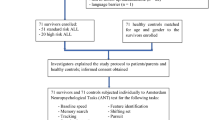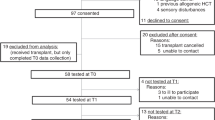Summary:
The purpose of this study was to describe the neuropsychological functioning of survivors of advanced stage neuroblastoma. In all, 16 survivors, diagnosed at a median of 2.8 years, who had received intensive chemotherapy and surgical treatments, were identified; 11 had received myeloablative consolidation therapy, eight with total body irradiation (TBI). All patients were evaluated with a neuropsychological assessment battery at a median age of 8.8 years. Analyses included comparison of the performances of the TBI group vs the no-TBI group; determination of whether the proportion of individuals with impaired or superior performance on each measure exceeded normative expectations; and performance indexes reflecting patterns of performance. Results indicate no significant deleterious impact of TBI and/or presence or absence of myeloablative therapy on neurocognitive and neurobehavioral functioning. For this cohort, resilience to neuropsychological vulnerability was observed, which included the emergence of a profile of full-scale IQ, verbal IQ, and mathematical achievement well above average expectations. We concluded that the results document a lack of neuropsychological morbidity among this cohort of survivors of advanced stage neuroblastoma, regardless of the inclusion of TBI. Moreover, a striking pattern of excellent neurocognitive functioning with intact neurobehavioral functioning was observed.
This is a preview of subscription content, access via your institution
Access options
Subscribe to this journal
Receive 12 print issues and online access
$259.00 per year
only $21.58 per issue
Buy this article
- Purchase on Springer Link
- Instant access to full article PDF
Prices may be subject to local taxes which are calculated during checkout
Similar content being viewed by others
References
Granowetter L . Pediatric oncology, a medical overview. In: Bearison D, Mulhern, RK (eds). Pediatric Psychooncology. Oxford University Press: New York, 1994, pp 9–34.
Kushner BH, Cheung NKV . Neuroblastoma: an overview. Hematol/Oncol Ann 1993; 1: 189–201.
Brodeur GM, Castleberry RP . Neuroblastoma. In: Pizzo PA, Poplack DG (ed.). Principles and Practice of Pediatric Oncology, 2nd edn. JB Lippincott: Philadelphia, 1993, pp 737–739.
Grupp SA, Stern JW, Bunin N et al. Tandem high-dose therapy in rapid sequence for children with high-risk neuroblastoma. J Clin Oncol 2000; 18: 2567–2575.
Grupp SA, Stern JW, Bunin N et al. Rapid-sequence tandem transplant for children with high-risk neuroblastoma. Med Pediator Oncol 2000; 35: 696–700.
Kletzel M, Katzenstein HM, Haut PR et al. Treatment of high-risk neuroblastoma with triple-tandem high-dose therapy and stem-cell rescue: results of the Chicago Pilot II Study. J Clin Oncol 2002; 20: 2284–2292.
Matthay KK, Villablanca JG, Seeger RC et al. Treatment of high-risk neuroblastoma with intensive chemotherapy, radiotherapy, autologous bone marrow transplantation, and 13-cis-retinoic acid. Children's Cancer Group. N Engl J Med 1999; 341: 1165–1173.
Arvidson J, Kihlgren M, Hall C et al. Neuropsychological functioning after treatment for hematological malignancies in childhood, including autologous bone marrow transplantation. Pediatr Hematol Oncol 1999; 16: 9–21.
Chou RH, Garrett BW, Kramer JH . Toxicities of total-body irradiation for pediatric bone marrow transplantation. Int J Radiat Oncol Biol Phys 1995; 34: 843–851.
Kramer JH, Crittenden MR, Halberg FE et al. A prospective study of cognitive functioning following low-dose cranial radiation for bone marrow transplantation. Pediatrics 1992; 90: 447–450.
Parth P, Kennedy RS, Lane NE et al. Motor and cognitive testing of bone marrow transplant patients after chemoradiotherapy. Percep Motor Skills 1989; 68: 1227–1241.
Schmidt GM, Niland JC, Forman SJ et al. Extended follow-up in 212 long-term allogenic bone marrow transplant survivors. Issues of quality of life. Transplantation 1993; 55: 551–557.
Smedler AC, Bergman H, Bolme P . Neuropsychological functioning in children treated with bone marrow transplantation. J Clin Exp Neuropsychol 1998; 10: 325–326.
Kaleita TA, Shields WD, Tesler A et al. Normal neurodevelopment in four young children treated with bone marrow transplantation for acute leukemia or aplastic anemia. Pediatrics 1989; 83: 753–757.
Phipps S, Brenner M, Heslop H et al. Psychological effects of bone marrow transplantation on children and adolescents: preliminary report. Bone Marrow Transplant 1995; 15: 829–835.
Phipps S, Dunavant M, Srivastava DK et al. Cognitive and academic functioning in survivors of pediatric bone marrow transplantation. J Clin Oncol 2000; 18: 1004–1011.
Simms S, Kazak AE, Gannon T et al. Neuropsychological outcome of children undergoing bone marrow transplantation. Bone Marrow Transplant 1998; 22: 181–184.
Kramer JH, Crittenden MR, DeSantes K et al. Cognitive and adaptive behavior 1 and 3 years following bone marrow transplantation. Bone Marrow Transplant 1997; 19: 607–613.
Smedler AC, Bolme P . Neuropsychological deficits in very young bone marrow transplant recipients. Acta Paediatr 1995; 84: 429–433.
Smedler AC, Nilsson C, Bolme P . Total body irradiation: a neuropsychological risk factor in pediatric bone marrow transplant recipients. Acta Paediatr 1995; 84: 325–330.
Wechsler D . Wechsler Intelligence Scale for Children-III (WISC-III). Psych Corp.: New York, 1991.
Kaplan E, Goodglass H, Weintraub S . Boston Naming Test. Lee and Febiger Inc.: Phil, 1983.
Jastak S . Wide Range Assessment of Memory and Learning. Adams and Sheslow: New York, 1990.
Beery K, Bukterica NA . Developmental Test of Visual Motor Integration. Psychological Assessment Resources, Inc.: Florida, 1997.
Bernstein JH, Waber DP . Developmental Scoring System for the Rey-Osterrieth Complex Figure. Psychological Assessment Resources: Florida, 1996.
Wechsler D . Wechsler Individual Achievement Test (WIAT). Psych Corporation: New York, 1992.
Reynolds CR, Kemphaus RW . Behavior Assessment System for Children (BASC). AGS, Inc.: Circle Pines, MN, 1994.
Bracken B . Multidimensional Self Concept Scale (MSCS). Pro-Ed: Austin, TX, 1992.
Corn BW, Yousem DM, Scott CB et al. White matter changes are correlated significantly with radiation dose. Observations from a randomized dose-escalation trial for malignant glioma (Radiation Therapy Oncology Group 83-02). Cancer 1994; 74: 2828–2835.
Freeman CR, Bourgouin PM, Sanford RA et al. Long term survivors of childhood brain stem gliomas treated with hyperfractionated radiotherapy. Clinical characteristics and treatment related toxicities. The Pediatric Oncology Group. Cancer 1996; 77: 555–562.
Reddick WE, Mulhern RK, Elkin TD et al. A hybrid neural network analysis of subtle brain volume differences in children surviving brain tumors. Magn Reson Imaging 1998; 16: 413–421.
Reddickaij WE, Russell JM, Glass JO et al. Subtle white matter volume differences in children treated for medulloblastoma with conventional or reduced dose craniospinal irradiation. Magn Reson Imaging 2000; 18: 787–793.
Armstrong CL, Hunter JV, Ledakis GE et al. Late cognitive and radiographic changes related to radiotherapy: initial prospective findings. Neurology 2002; 59: 40–48.
Armstrong CL, Stern CH, Corn BW . Memory performance used to detect radiation effects on cognitive functioning. Appl Neuropsychol 2001; 8: 129–139.
Meyers CA, Geara F, Wong PF et al. Neurocognitive effects of therapeutic irradiation for base of skull tumors. Int J Radiat Oncol Biol Phys 2000; 146: 51–55.
Armstrong C, Ruffer J, Corn B et al. Biphasic patterns of memory deficits following moderate-dose partial-brain irradiation: neuropsychologic outcome and proposed mechanisms. J Clin Oncol 1995; 13: 2263–2271.
Langer T, Martus P, Ottensmeier H et al. CNS late-effects after ALL therapy in childhood. Part III: neuropsychological performance in long-term survivors of childhood ALL: impairments of concentration, attention, and memory. Med Pediatr Oncol 2002; 38: 320–328.
Precourt S, Robaey P, Lamothe I et al. Verbal cognitive functioning and learning in girls treated for acute lymphoblastic leukemia by chemotherapy with or without cranial irradiation. Dev Neuropsychol 2002; 21: 173–195.
Butler RW, Cheung NK, Eddy J . Increased intellectual functioning in children with neuroblastoma. Child Neuropsychol 1996; 2: 77–82.
Acknowledgements
This work was supported by The Daniel Pitino Foundation, the Elizabeth Childs Murphy Trust and the David B Perini Jr Quality of Life Program.
Author information
Authors and Affiliations
Corresponding author
Rights and permissions
About this article
Cite this article
Carpentieri, S., Diller, L. Neuropsychological resiliency after treatment for advanced stage neuroblastoma. Bone Marrow Transplant 35, 1117–1122 (2005). https://doi.org/10.1038/sj.bmt.1704947
Received:
Accepted:
Published:
Issue Date:
DOI: https://doi.org/10.1038/sj.bmt.1704947
Keywords
This article is cited by
-
Late effects in children treated with intensive multimodal therapy for high-risk neuroblastoma: High incidence of endocrine and growth problems
Bone Marrow Transplantation (2014)
-
Long-term outcomes in children with high-risk neuroblastoma treated with autologous stem cell transplantation
Bone Marrow Transplantation (2007)



